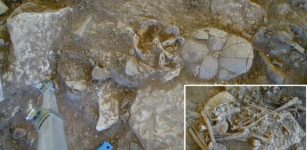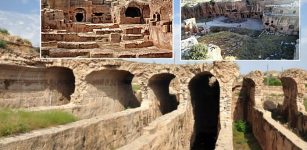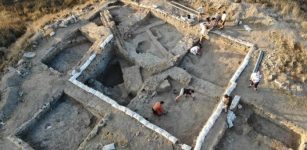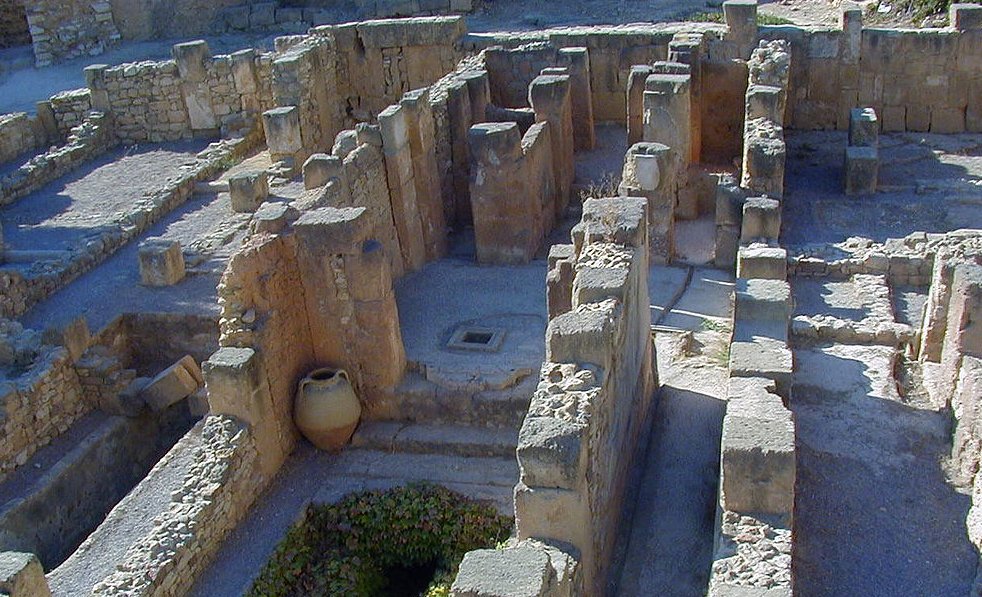Carthage: Prosperous Phoenician Colony That Became Dominant Power In The Western Mediterranean
A. Sutherland - AncientPages.com - The ruins of Carthage (its Phoenician name means 'Kart-hadasht '("new town")) are located approximately 18 km northeast of Tunis on the coast of North Africa and are surrounded by modern residences and beautiful gardens.
Modern reconstruction of Punic Carthage. The circular harbor at the front is the Cothon, the military port of Carthage, where all of Carthage's warships (Biremes) were anchored. Image credit: damian entwistle - CC BY-SA 2.0
An ancient legend strongly associates this place; it tells the story of the great city of Carthage, founded here nearly 3000 years ago.
This beautiful legend attributes the founding of Carthage to Elissa (Dido), a Phoenician princess from Tyre, sister of the King of Tyre - Pygmalion. Astonishingly, much of this story is historically accurate.
When Pygmalion killed Dido's husband, she and her children fled to North Africa.
Dido asked the Berber king Iarbas for a small bit of land for temporary refuge until she could continue her journey. Iarbas agreed to give her only as much land as could be encompassed by an oxhide. A clever woman had cut the skin into thin strips so that she had enough to encircle an entire nearby hill, which was afterward named Byrsa ('hide').
Carthage ruins. Image: Wikimedia commons
She founded Carthage on this piece of land. Many of the local Berbers joined the settlement, and both Berbers and envoys from the nearby Phoenician city of Utica urged the building of a city.
According to historical records, Carthage was not the Phoenicians' first colony, but in its early days, it became the largest and most famous city. It was an important political and commercial center, but researchers questioned the date of the foundation of Carthage.
Archaeological data indicate that the last quarter of the 8th century BC has yet to be discovered, an entire century later than the traditional foundation date.
The location of Carthage was very convenient and safe; it offered access to the Mediterranean but was shielded from violent storms. The city was well-protected and easily defensible. The ancient citadel, the Byrsa, was on a low hill overlooking the sea.
Some of the earliest tombs have been found there; the Byrsa area was once adorned with a large temple dedicated to Juno, Jupiter, and Minerva, and near it stood a temple to Asclepius. Also on the Byrsa site stood an open-air entrance, from which the finest Roman sculptures at Carthage have survived.
Baths of Antoninus, Carthage. Image: Wikimedia Commons
Surrounding Carthage were walls "of great strength," said in places to rise above forty feet (13 m) and be almost thirty feet (10 m) thick. To the west, three parallel walls were built. The walls encircled the city for about thirty-three kilometers.
The heights of the Byrsa were additionally fortified, this area being the last to succumb to the Romans in 146 BC.
No remains of Carthage's domestic and public buildings were unearthed. The city experienced its peak power in the third century BC. At the same age, however, Carthage was engaged in a series of wars with Rome, which ended with the city's destruction in 146 BC during the Third Punic War.
The First Punic War (264 - 241 BC) was a complete disaster for Carthage, causing it to lose the island of Sicily.
In the second Punic War (218 - 202 BC), Hannibal famously led his army and elephants over the Alps to attack the Romans on their soil. For many years, he led his victorious army up and down what is known today as Italy. On every battlefield, Hannibal defeated the Roman legions. Finally, he was lured for alleged peace negotiations to North Africa, and the Romans were able to beat him.
Punic ruins of Byrsa, Carthage. Image via Wikimedia commons
The third and final Punic War (149 - 146 BC) led to Rome's destruction of Carthage. That devastating defeat ended Carthage's brilliant time of glory. The city returned once more to the peaceful cultivation of its colonies and sea trade.
After decades, Carthage was reborn as a Roman colony; more precisely, the Roman province of "Africa" (with its capital in Carthage) became the granary of Rome and experienced another period of flowering until the fall of the Empire.
Throughout history, the city passed from hand to hand. After the Romans, the Byzantines came. In the year 439, Carthage was plundered by the Vandals, who, ten years earlier, had appeared in North Africa and made it to his capital. In 534, the city was recaptured by the Byzantine army of Belisarius. In the seventh century, the Arabs appeared in the regions, and in the sixteenth century, Carthage was in the hands of the Ottoman Empire.
Written by – A. Sutherland - AncientPages.com Senior Staff Writer
Updated on March 28, 2024
Copyright © AncientPages.com All rights reserved. This material may not be published, broadcast, rewritten or redistributed in whole or part without the express written permission of AncientPages.com
Expand for referencesReferences:
Polybius: The Histories
Goldsworthy Adrian, The Fall of Carthage: The Punic Wars 265-146BC
More From Ancient Pages
-
 Evidence Of Frightening Rituals Practiced By Ancient Steppe Nomads In Siberia – Discovered
Archaeology | Sep 19, 2020
Evidence Of Frightening Rituals Practiced By Ancient Steppe Nomads In Siberia – Discovered
Archaeology | Sep 19, 2020 -
 Neglected Ancient Artifacts That Could Re-Write History – Evidence Of Surprising Advanced Ancient Technology That Shouldn’t Exist
Ancient Mysteries | Feb 19, 2019
Neglected Ancient Artifacts That Could Re-Write History – Evidence Of Surprising Advanced Ancient Technology That Shouldn’t Exist
Ancient Mysteries | Feb 19, 2019 -
 Hidden Manuscripts Reveal Ancient Sacred Wisdom Of The Gods And Surprises
Ancient Mysteries | Mar 23, 2019
Hidden Manuscripts Reveal Ancient Sacred Wisdom Of The Gods And Surprises
Ancient Mysteries | Mar 23, 2019 -
 Well-Preserved Bronze Statues Discovered In Thermal Baths In Tuscany
Archaeology | Nov 11, 2022
Well-Preserved Bronze Statues Discovered In Thermal Baths In Tuscany
Archaeology | Nov 11, 2022 -
 Scientists Say Dinosaurs Could Be The Reason Humans Can’t Live For 200 Years
Featured Stories | Jan 8, 2024
Scientists Say Dinosaurs Could Be The Reason Humans Can’t Live For 200 Years
Featured Stories | Jan 8, 2024 -
 Secret Behind Ancient Durable Maya Plaster Discovered
Archaeology | Apr 21, 2023
Secret Behind Ancient Durable Maya Plaster Discovered
Archaeology | Apr 21, 2023 -
 Guide To The Classics: On The Art Of Physical Exercise, A 16th Century Account Of Ancient Sports And Workouts
Featured Stories | Jul 26, 2024
Guide To The Classics: On The Art Of Physical Exercise, A 16th Century Account Of Ancient Sports And Workouts
Featured Stories | Jul 26, 2024 -
 The 426-Km-Long Roman Aqueduct Provided Water For Constantinople – New Study
Archaeology | May 11, 2021
The 426-Km-Long Roman Aqueduct Provided Water For Constantinople – New Study
Archaeology | May 11, 2021 -
 Babylon Excavation Uncovers 478 Artifacts, Including Cuneiform Tablets and Seals
Archaeology | Oct 17, 2024
Babylon Excavation Uncovers 478 Artifacts, Including Cuneiform Tablets and Seals
Archaeology | Oct 17, 2024 -
 Extremely Rare Roman Glass Vase Adorned With A Message Found In France
Archaeology | Nov 18, 2020
Extremely Rare Roman Glass Vase Adorned With A Message Found In France
Archaeology | Nov 18, 2020 -
 On This Day In History: Maltese Rebellion Took Place – On Sep 8, 1775
News | Sep 8, 2016
On This Day In History: Maltese Rebellion Took Place – On Sep 8, 1775
News | Sep 8, 2016 -
 DNA Analyses Suggest The Plague Contributed To Stone Age Farmers’ Decline
Archaeology | Jul 10, 2024
DNA Analyses Suggest The Plague Contributed To Stone Age Farmers’ Decline
Archaeology | Jul 10, 2024 -
 Focus On Unique And Spectacular Gallery Grave In Ancient City Of Dara, Mardin
News | Aug 24, 2020
Focus On Unique And Spectacular Gallery Grave In Ancient City Of Dara, Mardin
News | Aug 24, 2020 -
 Ancient Mystery From The Age Of Taurus And The Murdered Astronomer – Overlooked Secret In The North – Part 1
Ancient Mysteries | Oct 30, 2019
Ancient Mystery From The Age Of Taurus And The Murdered Astronomer – Overlooked Secret In The North – Part 1
Ancient Mysteries | Oct 30, 2019 -
 Mysterious Disappearance Of The Eilean Mor Lighthouse Keepers Remains Unsolved
Featured Stories | Dec 21, 2018
Mysterious Disappearance Of The Eilean Mor Lighthouse Keepers Remains Unsolved
Featured Stories | Dec 21, 2018 -
 5,000-Year-Old Bryn Celli Ddu Funeral Complex Reveals More Secrets
Archaeology | Jun 28, 2017
5,000-Year-Old Bryn Celli Ddu Funeral Complex Reveals More Secrets
Archaeology | Jun 28, 2017 -
 Preserve Elfdalian: Sweden’s Secret Forest Language From The Viking Era
Civilizations | May 21, 2015
Preserve Elfdalian: Sweden’s Secret Forest Language From The Viking Era
Civilizations | May 21, 2015 -
 Huge Defensive Wall Excavated At Tel Erani, Israel Is More Than 5,300 Years Old
Archaeology | Sep 12, 2019
Huge Defensive Wall Excavated At Tel Erani, Israel Is More Than 5,300 Years Old
Archaeology | Sep 12, 2019 -
 On This Day In History: Macbeth, King of Scots Killed At The Battle Of Lumphanan – On August 15, 1057
News | Aug 15, 2016
On This Day In History: Macbeth, King of Scots Killed At The Battle Of Lumphanan – On August 15, 1057
News | Aug 15, 2016 -
 Diyu – Terrible Chinese Hell And Judgement Of God Yama
Chinese Mythology | Dec 18, 2018
Diyu – Terrible Chinese Hell And Judgement Of God Yama
Chinese Mythology | Dec 18, 2018




